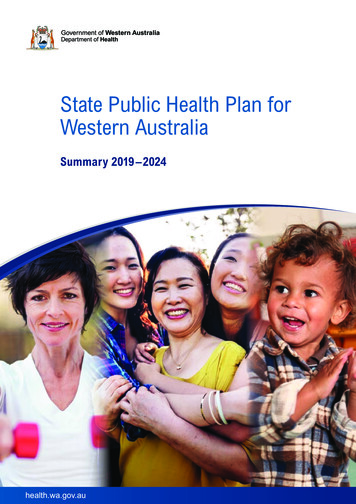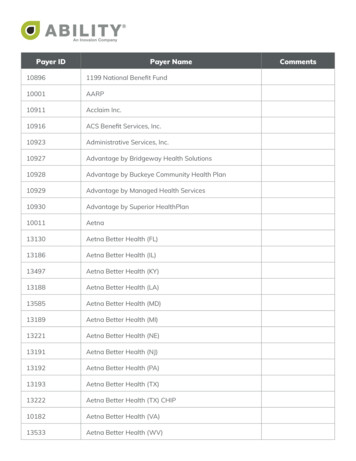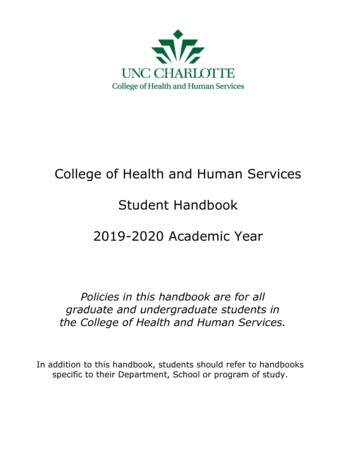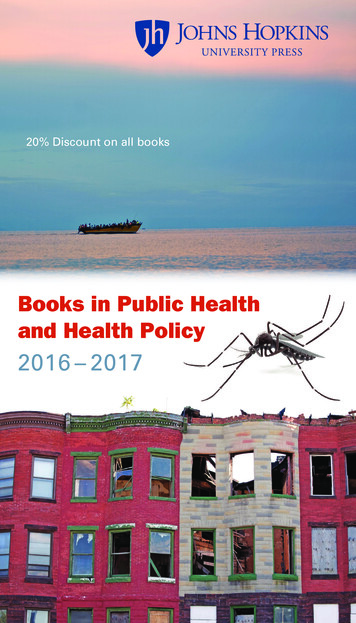
Transcription
State Public Health Plan forWestern AustraliaSummary 2019 –2024health.wa.gov.au
This document was prepared by:Public and Aboriginal Health DivisionDepartment of Health of Western AustraliaPO Box 8172Perth Business Centre WA 6849Email: publichealthact@health.wa.gov.auWeb: www.health.wa.gov.auDisclaimerAll information and content in this material is provided in good faith by the WA Department of Healthand is based on sources believed to be reliable and accurate at the time of development. The State ofWestern Australia, the WA Department of Health and their respective officers, employees and agentsdo not accept legal liability or responsibility for the material, or any consequences arising from its use.AcknowledgementsThe Department of Health would like to thank the people and organisations who contributed time andexpertise to the development of the State Public Health Plan.FeedbackAny feedback related to this document should be emailed to publichealthact@health.wa.gov.au
We want the people of WAto experience the bestpossible health, wellbeingand quality of life.Acknowledgment of Country and PeopleWA Health acknowledges the Aboriginal people of the many traditional lands and language groups ofWestern Australia. It acknowledges the wisdom of Aboriginal Elders both past and present and paysrespect to Aboriginal communities of today.
Message from the Minister for Healthand Mental HealthI am proud to present the first State Public Health Plan(the Plan) for Western Australia. The Plan representsan important step towards a coordinated approach toimproving the health and wellbeing of Western Australians,be it at the State-wide or local community level.Our vision is for Western Australians to live well and experience the bestpossible health, wellbeing and quality of life. Strengthening partnerships,particularly with local governments across WA, is the key to fulfilling thisvision, and to the success of the Plan.The Plan identifies three public health objectives that will help preventdisease, injury and premature deaths in WA. These objectives are to:1. Empower and enable people to live healthy lives2. Provide health protection for the community and3. Improve Aboriginal health and wellbeing.These objectives are supported by policy priorities that focus attention on the areas of public healthwhere there is potential to make improvements across government.While we enjoy a high standard of living in WA, it’s a sobering thought that, between 2011 and 2015, overhalf of all deaths of Western Australians aged under 75 years could potentially have been avoided.Moreover, life expectancy is significantly lower for Aboriginal men and women compared with nonAboriginal Western Australians. To address this health gap, the Plan recognises that Aboriginal health andwellbeing must be considered the core business of everyone.Western Australian local governments are vital in protecting and promoting the health and wellbeing oftheir residents, and can play a huge role in reducing disease, illness and injuries. Local governments willsoon be required to have local public health plans. The development of these local plans will ensure localgovernments can continue to contribute and plan for the health and wellbeing of their communities.Local governments are not in this alone. Support is available and there are many avenues to partner tocomplement local government programs and activities.I encourage all Western Australians to consider what role they can play to facilitate a culture of wellnessfor the people of our wonderful State.Roger Cook MLADeputy Premier; Minister for Health;Mental Health2 State Public Health Plan for Western Australia Summary
Message from the Chief Health Officerof Western AustraliaI am pleased to release this State Public Health Plan(the Plan) to guide the direction of public health planningacross WA. The Plan establishes high level strategicdirections that focus on prevention, health promotionand health protection that aim to prevent disease, injury,disability and premature death in WA.The Plan has been updated to reflect the extensive feedback receivedfrom local government, state government, public health experts andcommunity members during a six month consultation process acrossWA. From the many ideas raised we have addressed a number of the keypublic health concerns within this final version.An important achievement has been the collaboration and partnership with the Mental HealthCommission to incorporate mental health and other drug related priorities for the State. There wasoverwhelming support from stakeholders, particularly local governments, about the importance ofrecognising and strengthening the role local governments can play in helping to influence the mentalhealth and wellbeing of communities.I strongly encourage local governments to use this plan to guide the continuation, or commencement, oftheir local public health plans. I am pleased to see that many local governments have already taken theinitiative and produced high quality public health plans that contribute towards supporting the health andwellbeing of their local communities.I am excited about strengthening our collective effort to create liveable, vibrant places where all WesternAustralians experience the best possible health, wellbeing and quality of life.Dr Andrew RobertsonChief Health OfficerPublic and Aboriginal Health DivisionDepartment of Health Western AustraliaState Public Health Plan for Western Australia Summary 3
Public health objectives and policy priorities summaryObjective 1: Empowering and enabling people to live healthy livesHealthy eatingA more active WACurbing the rise in overweight and obesityMaking smoking historyReducing harmful alcohol useReduce use of illicit drugs, misuse of pharmaceuticals and other drugs of concernOptimise mental health and wellbeingPreventing injuries and promoting safer communitiesObjective 2: Providing health protection for the communityReduce exposure to environmental health risksAdminister public health legislationMitigate the impact of public health emergenciesSupport immunisationPrevention and control of communicable diseasesPromote oral health improvementObjective 3: Improving Aboriginal health and wellbeingPromote culturally secure initiatives and servicesEnhance partnerships with the Aboriginal communityContinue to develop and promote Aboriginal controlled servicesEnsure programs and services are accessible and equitablePromote Aboriginal health and wellbeing as core business for all stakeholders4 State Public Health Plan for Western Australia Summary
IntroductionThis State Public Health Plan establishes high level strategic directions that focus onprevention, health promotion and health protection which aim to prevent disease,illness, injury, disability and premature death in WA.Public health planning is soon to be a mandatory requirement under Part 5 of the Public Health Act 2016.This process strengthens the need to better plan for public health and wellbeing by both the State andlocal governments.Part 5 of the Public Health Act 2016 introduces the requirement for the preparation of a:1. State public health plan prepared by the Chief Health Officer, and a2. Local public health plan prepared by each local government.This State Public Health Plan is intended to guide local governments commencing or continuing thepublic health planning process. The Plan provides a framework for local governments to consider andadapt as necessary to reflect the particular risks prevailing in their local district.This document summarises the key public health objectives and policy priorities for WA. The detailedversion of the WA State Public Health Plan can be viewed on the Department of Health websitewww.health.wa.gov.auWhat is public health?The Public Health Act 2016 defines public health as:a) the wider health and wellbeing of the community andb) the combination of safeguards, policies and programs designed to protect, maintain, promote andimprove the health of individuals and their communities and to prevent and reduce the incidence ofillness and disability.Public health is.Safe andnutritious foodThe way ourcommunities aredesignedSafe drinking waterWalking trails andcycle routesSmoke and alcoholfree environmentsWaste managementRecreational facilities,sports groundsand parksEvents, places andactivities that bring thecommunity togetherHealth information andeducation programsSafe housingMaintaining high levelsof immunisationOptimal mental healthand wellbeingState Public Health Plan for Western Australia Summary 5
Snapshot of the health of Western AustraliansPopulation overviewAs of 2018 thepopulationof WA was2.6 millionaBy 2066 it is estimatedthat 1 in 5 WesternAustralians will beover 65 years of age cIn 2016 Aboriginalpeople comprised of3.9% of the State’spopulation, withapproximately halfof the Aboriginalpopulation agedunder the age of 25 eIn 2015, approximately362,000In 2016,59.8%of Aboriginal people livedoutside metropolitan Perth bMental healthand wellbeingIn 2017-18, more than 1 in 6(17.8%) Western Australianadults had a mental orbehavioural condition gIn 2016, almost 1 in 3 peoplein WA were born overseas dHealth protection for the communityHeatwaves are responsible for more deathsin Australia than any other natural disasterand will likely worsen with climate change i96%of childrenaged 24 to 27 monthsin WAwere fully vaccinated forhepatitis Bin 2018 jWA’s suicide rate was morethan 20% higher than thenational average in 2017and has been consistentlyhigher than the nationalaverage since 2008 hWestern Australiansreported havinga disability f499The number and rate ofRoss Rivervirusrecorded in 2018-19 ksexual transmittable infectionsNumbers ofremains high in WA withnotifications ofChlamydia in 20186 State Public Health Plan for Western Australia Summary11,524l
Lifestyle risk factorsIn 2015, chronicdisease andinjury wereresponsible forapproximately65% of the total diseaseburden in Australia m69%In 2011-12WA adultsof WA adults aged16 years and overobtained 36%were classified asoverweightor obeseof their daily total energyintake from unhealthy foods qin 2017 oOne in four childrenin WA were classified asoverweight or obesein 2017 pIn WA in 2017approx 1/3 ofpeople aged16-44 years(35.7%)drink at levels considered to behigh risk for long-term harm n41%of Aboriginal peopleaged 15 years and over in WAweredaily smokersin 2014-15 rAboriginal healthBetween 2013 and 2015,potentially preventablehospitalisation rates forAboriginal people in WAAboriginalWestern Australiansexperience a significant gapin life expectancy;a gap of 13.4 yearsfor males and12 years for femalescompared withnon-Aboriginal peoples4.1xwere 4.1 times greater thanfor non-Aboriginal peopletIn 2012–13, 67% of Aboriginal peoplein WA aged 15 andover wereoverweight (28%)or obese (39%)uState Public Health Plan for Western Australia Summary 7
Costs of inactionThere is good evidence that prevention offers cost-effective ways to improve health outcomesin Australia. Prevention makes good sense.In high-income countrieswith universal healthcare,it has been estimated that forevery 1 invested in public health,there will be a 14 return on this investmentv 715m 715 million of hospital costs in WA wereattributed to chronic conditions in 2013wabcdefghijklmnopqrstuvwxy 176 millioninvested in tobaccoprevention in Australiabetween 1971 and 2010 averted approximately 8.6 billion in health costs over that periodx 350mIn 2013, hospital costs in WA for injury werejust short of 350 millionyAustralian Bureau of Statistics, 2018. Australian Demographic Statistics, Sep 2018. Cat. No. 3101.0 Canberra: ABSAustralian Bureau of Statistics, 2018. Estimates of Aboriginal and Torres Strait Islander Australians, June 2016. Cat. No. 3238.0.55.001 Canberra: ABSAustralian Bureau of Statistics, 2018. Population Projections, Australia, 2017 (base) to 2066. Cat. No. 3222.0 Canberra: ABSAustralian Bureau of Statistics, 2018. Migration, Australia, 2016-17. Cat. No. 3412.0 Canberra: ABSAustralian Bureau of Statistics, 2018. Estimates of Aboriginal and Torres Strait Islander Australians, June 2016. Cat. No. 3238.0.55.001 Canberra: ABSAustralian Bureau of Statistics, 2016. Disability, Ageing and Carers, Australia: Summary of Findings, 2015. Cat. No. 4430.0 Canberra: ABSAustralian Bureau of Statistics, 2019. National Health Survey: First results, 2017-18. Cat. No. 4364.0.55.001. Canberra: ABSAustralian Bureau of Statistics. Causes of Death, Australia, 2017. cat. no. 3303.0. Canberra; 2018Scalley B, Spicer T, Jian L et al. 2015. Responding to heatwave intensity: Excess Heat Factor is a superior predictor of health service utilisationand trigger for heatwave plans. Australian and New Zealand Journal of Public Health. Vol 39(6): 582-587.Australian Immunisation Register (AIR), 2019. Childhood immunisation coverage. Canberra: Commonwealth Department of HealthWA Department of Health, 2019. Notifiable Infectious Disease Reports: Ross River virus notifications in Western Australia. Perth: WA Departmentof HealthDepartment of Health, 2018. National Notifiable Diseases Surveillance System: Canberra, Department of HealthAustralian Institute of Health and Welfare 2019. Australian Burden of Disease Study: impact and causes of illness and death in Australia 2015.Australian Burden of Disease series no. 19. Cat. no. BOD 22. Canberra: AIHWMerema M, Radomiljac A, 2018. Health and Wellbeing of Adults in Western Australia 2017, Overview and Trends. Perth: WA Department of HealthMerema M, Radomiljac A, 2018. Health and Wellbeing of Adults in Western Australia 2017, Overview and Trends. Perth: WA Department of HealthMerema M and Radomiljac A, 2018. Health and Wellbeing of Children in Western Australia in 2017, Overview and Trends. Perth: WA Departmentof HealthAustralian Bureau of Statistics. 4364.0.55.009 – Australian Health Survey: Nutrition – State and Territory results, 2011-12. Canberra: AustralianBureau of Statistics, 2015.Australian Bureau of Statistics, 2016. What does the 2014-15 NATSISS tell us about Western Australia? National Aboriginal and Torres StraitIslander Social Survey, 2014-15, Cat no. 4714.0. Canberra: ABSAustralian Bureau of Statistics, 2018. Life Tables for Aboriginal and Torres Strait Islander Australians, 2015-2017. Cat. No. 3302.0.55.003.Canberra: ABSAustralian Institute of Health and Welfare 2017. Aboriginal and Torres Strait Islander Health Performance Framework 2017 report: WesternAustralia. Cat. no. IHW 185. Canberra: AIHW.Australian Institute of Health and Welfare 2017. Aboriginal and Torres Strait Islander Health Performance Framework 2017 report: WesternAustralia. Cat. no. IHW 185. Canberra: AIHW.Masters R, Anwar E, Collins B, et al (2017) Return on investment of public health interventions: a systematic review. J Epidemiol CommunityHealth; 71:827-834Epidemiology Branch. Costs and cost projections for injury and chronic disease hospitalisations, HMDS. Department of Health WA. Perth; 2016.Chronic Disease Prevention Directorate. Western Australian Health Promotion Strategic Framework 2017–2021.Perth: Department of Health,Western Australia; 2017.Epidemiology Branch. Costs and cost projections for injury and chronic disease hospitalisations, HMDS. Department of Health WA. Perth; 2016.8 State Public Health Plan for Western Australia Summary
VisionWe want the people of WA to experience the best possible health, wellbeing andquality of life.It is important that Western Australians are supported to actively participate in community life and thatthe places and spaces where they live, learn, work and play are safe, clean, green and accessible.Determinants of healthThere are many factors that influence a person’s health and wellbeing. Aspects of the surroundingenvironment in which people live, income, genetics, features of community life, and social connectionsand relationships all influence an individual’s health1.ral and envc, tionsIndivrsctoAgricultureand foodproductionUnemploymentcommunity ndnetwaalal lifestyle fauidSociWork ksorEducation Age, sex andconstitutionalfactorssonitindGeneralImproving health outcomes starts with giving people more opportunities to make choices that supportthem to lead healthier, more active lives, regardless of their income, education or cultural background.Water andsanitationHealth careservicesHousingDiagram 1: A framework for the determinants of health. Source: the Australian Institute of Healthand Welfare2Priority populationsTargeted interventions to reduce health inequities and to assist those in the community who have ahigher risk of exposure to health risk factors are essential. The main priority populations in WA includeAboriginal people, those living in low socioeconomic circumstances, people with mental illness ordisabilities, carers and families of people with sickness, populations living in rural and remote areas andCulturally and Linguistically Diverse (CALD) populations, particularly those people who have recentlyarrived in Australia.12World Health Organization, Social Determinants of Health. 2017 Available from www.who.int/social determinants/enAustralian Institute of Health and Welfare, National Health Performance Framework (2nd edition), f-australias-healthState Public Health Plan for Western Australia Summary 9
Our vision for a healthier WAWe want the people of WA to experience the best possible health, wellbeing andquality of life. It is important that Western Australians are supported to activelyparticipate in community life and that the places and spaces where they live, learn,work and play are safe, clean, green and accessible.10 State Public Health Plan for Western Australia Summary
State Public Health Plan FrameworkVisionWe want the people of WA to experience the best possible health, wellbeing and quality of life.ObjectivesObjective 1:Objective 2:Objective 3:Empowering and enablingpeople to live healthy livesProviding health protectionfor the communityImproving Aboriginal healthand wellbeingPriority risk factors for WAEnvironmental health risksPoor dietHarmful use of alcoholInsufficient physical activityOverweight and obesityIllicit drug use and misuseof pharmaceuticalsSmokingMental health issuesCommunicable disease risksUnprotected sex withinfected personsLow immunisation ratesOutcomesImproved public health and wellbeing of communities and vulnerable groupsReduced incidence of preventable illness, injury, disability and premature deathActionsExisting programsand activitiesNew and emergingwork prioritiesFocus on prioritypopulationsMonitoring and reportingAnnual review by individual program areasIndividual program areas report through existing systemsFive year review of the State Public Health Plan to support enactmentof Part 5 of the Public Health Act 2016Guiding principles of the Public Health Act rgenerationalequityLocal governmentState Public Health Plan for Western Australia Summary 11
State PublicHealth PlanObjectives12 State Public Health Plan for Western Australia Summary
Public health objectives for WAThe following objectives represent the areas of public health priority for WA. By focusing action on thesepriority areas, we can aim to achieve the biggest gains in minimising deaths, burden of disease, reducinginjury, and improving the quality of life for people living in WA.The objectives and policy priorities identify high level strategic directions that focus on the promotion,improvement and protection of public health, and support the delivery of preventive public healthservices. It is important that these objectives and priorities are not viewed as separate and discrete, butrather that they each interrelate. By addressing improvements in one area; such as encouraging physicalactivity, improvements may occur in other areas; such as improving the mental health and wellbeing ofindividuals.It is important that Aboriginal health and wellbeing is viewed as core business across all public healthpolicy priorities. While Objective 3 details how initiatives are likely to maximise their effectiveness inimproving Aboriginal health and wellbeing, the unique needs of this population must be consideredwithin all policy priorities within Objectives 1 and 2.The three objectives of the Plan include:Objective 1 – Empowering and enabling people to live healthy livesObjective 2 – Providing health protection for the communityObjective 3 – Improving Aboriginal health and wellbeingState Public Health Plan for Western Australia Summary 13
Objective 1: Empowering and enablingpeople to live healthy livesWestern Australians need to feel empowered and enabled to live healthy lives, such as eating morenutritious foods, taking action to keep active and making the time to focus on their overall health andwellbeing.There are significant opportunities to improve the health and wellbeing of the WA population by improvingthe surrounding environment to create vibrant, liveable neighbourhoods that offer a sense of belonging,culture and spirit, and by facilitating behaviour change to support people to lead healthier lifestyles.Consideration can be given to:*designing neighbourhoods that make it easier for people to walk or cycle*making it easier to access affordable fruit and vegetables***decreasing unhealthy food and drink sold in publicly-owned facilities such as schools, hospitals,and sport and recreation centrescreating green streetscapes by planting street trees along footpaths to encourage people to walkaround the local neighbourhoodmaking sure the community is safe and injuries are prevented by providing lighting for streets andpublic spaces, designing safe footpaths, roads and intersections and making sure playgrounds haveseating and lots of shade*supporting community services and events that encourage social connectedness and inclusion*creating activated community spaces for people to meet and interact**acknowledging heritage and cultural features in design and highlighting neighbourhood stories andhistory anddeveloping local policies to address key public health issues including a: whole organisation approach to alcohol and drug management smoke free outdoor policy shade policy for public open spaces and a built environment policy to incorporate healthy urban design principles to the local environment.Policy prioritiesPriority activities1.1Healthy eating1. Foster environments that promote and support healthy eating patterns2. Increase availability and accessibility of quality, affordable, nutritious food3. Increase the knowledge and skills necessary to choose a healthy diet1.2A more activeWA1. Promote environments that support physical activity and reduced sedentarybehaviour2. Reduce barriers and increase opportunities for physical activity across allpopulations3. Increase understanding of the benefits of physical activity and encourageincreased activity at all stages of life4. Motivate lifestyle changes to reduce sedentary behaviour14 State Public Health Plan for Western Australia Summary
Policy prioritiesPriority activities1.3Curbing the risein overweightand obesity1. Promote environments that support people to achieve and maintain a healthyweight2. Prevent and reverse childhood overweight and obesity3. Motivate behaviour to achieve and maintain a healthy weight among adults1.4Making smokinghistory1. Continue efforts to lower smoking rates2. Eliminate exposure to second-hand smoke in places where the health ofothers can be affected3. Reduce smoking in groups with higher smoking rates4. Improve regulation of contents, product disclosure and supply5. Monitor emerging products and trends1.5Reducingharmful alcoholuse1.2.3.4.1.6Reduce use ofillicit drugs,misuse ofpharmaceuticalsand other drugsof concern1. Increase helpseeking behaviour and reduce stigma around illicit drugs andemerging drugs of concern2. Support state-wide evidence-based strategies to prevent and reduce illicitdrug use and related harms3. Increase awareness of the harms associated with illicit drug use, while notbeing stigmatising4. Continue to mobilise communities and other stakeholders to work in partnershipon evidence-based prevention activities addressing drug use and related harm5. Develop personal skills, targeted public awareness and engagement regardingmisuse of pharmaceuticals and other drugs of concern1.7Optimise mentalhealth andwellbeing1. Increase public awareness about mental health and wellbeing, and suicideprevention2. Build community capacity to reduce stigma, increase awareness of where togo for help, and promote strategies to optimise mental health and wellbeing3. Create and maintain supportive environments that increase socialconnectedness and inclusion, community participation and network1.8Preventinginjuries andpromoting safercommunities1.2.3.4.5.6.7.8.9.Change community attitudes towards alcohol useInfluence the supply of alcohol in accordance with the Liquor Control Act 1998Reduce demand for alcoholPromote environments that support people not to drink or to drink at low-risklevelsProtect children from injuryPrevent falls in older peopleReduce road crashes and road traumaImprove safety in, on and around waterReduce interpersonal violenceDevelop the injury prevention and safe communities sectorMonitor emerging issues in injury preventionPromote sun protection in the communityPrevent and reduce alcohol intoxicationState Public Health Plan for Western Australia Summary 15
Objective 2: Providing health protectionfor the communityThe health and safety of the WA communityhas been maintained to a high standarddue to the long standing public andenvironmental health services managed byState and local governments across WA. Thesuccessful implementation of these serviceshas helped to prevent, reduce or eveneliminate the prevalence of many diseases,illness and injury.It is essential that governments continue toinvest in and manage these traditional publicand environmental health services whichplay a critical role in preventative health. Thisincludes the enforcement of regulations andguidelines, the management of surveillanceand assessment programs and public education which are designed to provide clean air, safe food andwater, and a hazard free environment.Governments must also be capable of planning for and responding to emerging risks, such as the healthimpacts associated with climate change, diseases that may emerge or increase, or changes to industriesthat may present health concerns.Providing health protection for the community requires consideration of:***Administering and enforcing compliance with public health legislation, such as inspecting foodbusinesses to reduce food-borne disease risks, assessing body piercing and tattoo parlours toreduce blood-borne virus risks, and monitoring swimming pools to reduce water-borne diseaserisks and injuriesSupporting safe community events, homes and public buildingsResponding to community concerns about inappropriate needle and syringe disposal andsupporting needle and syringe programs*Promoting and supporting immunisation of children and high risk groups in the community*Supporting the investigation and reporting of disease outbreaks and other health risks****Increasing awareness about common risks such as asbestos, water hazards and food safetypracticesImplementing strategies to minimise mosquito breeding sites and reduce mosquito-bornedisease risksAssessing development applications for potential health impacts and implementing strategies toaddress these risks in the early planning phases of projectsPlanning for extreme weather events such as floods, droughts, bushfires and storms to ensureeffective responses can take place.16 State Public Health Plan for Western Australia Summary
Policy prioritiesPriority activities2.1Reduce exposureto environmentalhealth risks1. Maintain safe food and water2.2Administerpublic healthlegislation1. Continue to administer, enhance and provide policy support for public healthlegislative instruments, including:2. Maintain healthy built environments3. Manage environmental hazards to protect community health4. Improve the environmental health conditions in remote Aboriginal communitiesa) Public Health Act 2016b) Health (Miscellaneous Provisions) Act 1911 and subsidiary legislationc) Food Act 2008d) Medicines and Poisons Act 2014e) Tobacco Products Control Act 2006f) Liquor Control Act 19882.3Mitigate theimpacts ofpublic healthemergencies1. Ensure public health emergencies are included in emergency and disasterplanning2. Maintain continuous improvement in the response to public health emergencies3. Strengthen the preparedness and resilience of communities against extremeweather events, with a focus on the most vulnerable in the community4. Establish a climate change adaptation plan to protect public health from theharmful health impacts of climate change2.4Supportimmunisation1. Continue efforts to increase vaccination coverage for young children,adolescents and adults2. Improve immunisation education and consent processes3. Sustain mechanisms for the surveillance and follow-up of suspected adverseevents following immunisation2.5Preventionand control ofcommunicablediseases1. Coordinate state-wide surveillance of notifiable communicable diseases2. Conduct and coordinate outbreak investigations of communicable diseases3. Continue to support and enhance disease control prevention and educationprograms delivered by stakeholders, including access to hardware andequipment to prevent communicable diseases4. Eliminate stigma and discrimination around sexually transmitted infectionsand blood-borne viruses5. Maintain and improve partnerships with stakeholders engaged incommunicable disease control activities2.6Promoteoral health
initiative and produced high quality public health plans that contribute towards supporting the health and . Healthy eating A more active WA Curbing the rise in overweight and obesity . a Australian Bureau of Statistics, 2018. Australian Demographic Statistics, Sep











